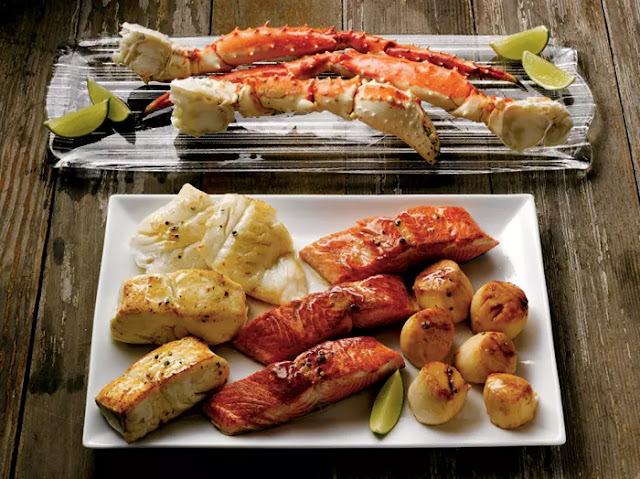The term “sustainable seafood” can mean many things. We trekked to Alaska—a leading frontier of the sustainable movement—to learn more.
It was just a few months ago that I was on the deck of a fishing boat, bundled up in my raingear and rubber boots, casting for longline halibut off the rocky waters of Alaska. A paltry seven fish and one weary, seasick reporter later, we called it a day.
What was exhausting for me that day is simply business as usual for fishermen and women around the world. Fisherwomen such as Claire Neaton and Emma Teal Laukitis. The two sisters, based out of Homer, Alaska, are part of a small but committed set of businesses committed to carrying on their family’s legacy of sustainable fishing. “What we’ve grown up knowing is a respect for the fish that we’re catching, and the wild resources that Alaska harvests,” says Laukitis, 26, by phone. “We think a lot about keeping this resource around us for generations, knowing that it’s sustained a lot of people and our culture and traditions.”
As second-generation fisherwomen, the sisters can work up to 14-hour days during salmon season (mid-June to late August), catching wild Alaska salmon in Prince William Sound and delivering it to port every few days. When halibut season arrives in September, they travel to the Bering Sea, switching out their nets for hooks. They work furiously until winter sets in; then, it’s time to switch gears and run Salmon Sisters, their ocean-inspired business which sells lifestyle products.
When it comes to keeping sustainable seafood practices alive, the sisters say that everything they catch is recorded and used. Or, if the fish is too young and not large enough to harvest, it will be discarded back into the water.
“You’re feeding the world a superfood,” says Neaton, 27. “It’s neat to be able to completely stand up for and understand the entire process between this beautiful fish coming out of the ocean and how it reaches a consumer’s plate.”
As the only state with a mandate for sustainable seafood written into its constitution, Alaska is king when it comes to wild seafood, supplying more than half of all wild-caught seafood in the United States. Its pristine Pacific waters are home to an abundant population of salmon, halibut, cod, crab, weathervane scallops, spot prawns and more. Off the state’s coastline, you’ll find more than 40 Marine Protected Areas which cover nearly a million square nautical miles and have enforced sustainable fishing practices and a number of governmental protection acts in place—including the Marine Mammal Protection Act and the Endangered Species Act—to ensure enough catch remains for the future. Since wild seafood is one of the state’s most precious resources, Alaska is willing to go to extremes to protect its long-term sustainability—a focus since its statehood became official in 1959.
Globally, the term “sustainable seafood” is used more broadly. It refers to the practice of catching or farming fish and shellfish in a manner that will maintain or increase production in the long term without harming the health of the species, the ocean and the surrounding eco-systems. Leaders in sustainability beyond Alaska’s waters include the Philippines, Barbados, Norway, South Korea and Iceland. However, there are still other parts of world, and other United States’ coastlines, that maintain sustainable practices for some—but not all—species.
With fish arriving at your supermarket from multiple countries and with differing labels, it can be confusing to know what’s really sustainable. Several non-profit organizations have stepped in to make it easier—and to keep commercial fisheries accountable. Monterey Bay Aquarium’s Seafood Watch and the Marine Stewardship Council (MSC) have designated rating systems and labels to help consumers make the right shopping choices for each species, which takes into consideration the overall ecosystem as well as management regulations (including the catch method and overall supply for wild; waste treatment and discharge for farmed). The MSC offers a blue label, designating sustainably caught wild fish or seafood that’s up to its standards. Seafood Watch has a handy free app which uses a color-coded system to label fish for consumption: green for “Best Choice, orange for “Good Alternative,” and red for “Avoid.”
When in doubt, Neaton and Laukitis advise turning to your fishmonger for details. He or she should always know the origin of the fish on display.
Sustainable Canned Seafood Brands:
Depending on where you live, canned can be a better option than fresh—and sometimes the only sustainable choice. Here are several companies approved by the MSC:
Raincoast Global
Wild Planet Foods
Natural Sea
Vital Choice
Bela
Depending on where you live, canned can be a better option than fresh—and sometimes the only sustainable choice. Here are several companies approved by the MSC:
Raincoast Global
Wild Planet Foods
Natural Sea
Vital Choice
Bela



0 Comments